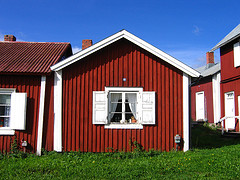If you ever come to Aix la chapelle (Aachen) and walk through the charming old town centre you’ll see very slim houses. When you enter them you’ll find that they are deep, tube-like.
For a long time I thought that that’s just how they build in medieval times and maybe that’s a factor, but a metric was important as well: Turns out that taxes were paid based on how wide the front of your house is. This metric drove people to build slim houses to minimize costs.
Once I was in an older building in Spain. Curiously the floor labeled “1” was already the 3rd floor. Strange, huh? Not if you know that houses used to be taxed by number of levels. That’s why people invented names like “entrepiso” for the 1st floor and sometimes even 2nd floor and henceforth did not count them as levels. Now you’ve got 8 level buildings, posing as 6 level ones.

In Sweden many people have a summer house on one of the islands. These summer houses may not exceed a certain size. This is verified via helicopters checking roof sizes. But they don’t check the number of houses. In effect, where in other countries you’d build an additional room, swedes build a new tiny summer house, dedicated to a single purpose. Just like a room 😉
When I was in Egypt in 2008 I noticed all these unfinished buildings. Surprise! You don’t have to pay taxes for unfinished buildings, i.e. those without a roof. Put in the floor for a level you never mean to finish and – Booya! – you’re good to go. You’ve got a quasi-roof without being taxed.
Why am I telling you all of this? Well, it’s just one more cautionary tale of the power of metrics. They shape cities and they shape companies so pick well. Lots of tiny houses may still be charming, even if the intent of the metric failed. Lots of unfinished buildings are not even that.
